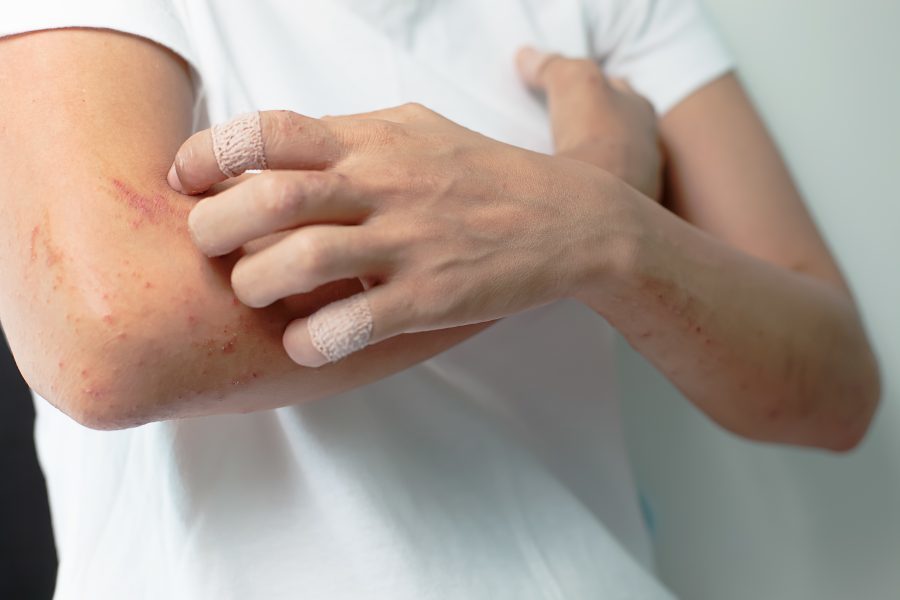Around 20-40% of cases of childhood atopic eczema go into adolescent and adult atopic dermatitis. The adult atopic dermatitis has a similar distribution to the childhood atopic dermatitis with more pronounced thickening of the skin and increased skin markings.
Signs and Symptoms of Adult Atopic Dermatitis
The chronic eczema changes are more on the flexures and hands. In adolescents and young females, eczema of the nipples is common, with scaling, crusting, and, at times, acute exacerbation characterized by oozing and severe itching.
Lip borders show itchy skin rashes in many cases of adult atopic dermatitis. Hair follicle related thick bumps are seen in the black skinned and the Japanese.
Adult atopic eczema cases are more sensitive to sunlight, and may present with itchy skin rashes on the exposed areas like the face, outer forearms, neck etc.
Atopic hand eczema is a feature of both childhood atopic dermatitis and adult atopic dermatitis. The fingers and palms show crusty scales with fissures at places, which are very painful and often bleed following minor pressure. In adult eczema, the hand eczema is more thickened and lichenified.
Lichenification is the characteristic feature of chronic eczema, and includes thickening, increased skin markings and pigmentation of the involved skin. Lichenification is the result of constant scratching and rubbing of the skin. Half of the patients with hand eczema also have eczema of the feet.
Adult atopic dermatitis patients are more prone for occupational contact dermatitis than normal people.
The skin in adult atopic eczema patients is very dry. This could be due to loss of water through the epidermal cells which lose their coherence and barrier function in atopics; the dryness predisposes the skin to the itchy skin rash in atopic eczema.
Differential Diagnosis of Adult Atopic Eczema
Scabies
Contact Dermatitis
Drug eruptions
Seborrheic Dermatitis
Treatment of Adult Atopic Dermatitis
General advice and reassurance
Avoidance of triggering factors: soaps and detergents, food, airborne allergens, stress etc. Food hypersensitivity is less common in adult atopics than in infantile atopic dermatitis and childhood atopic dermatitis.
Topical therapy: Oatmeal baths and application of emollients to avoid dry skin. Adult atopic dermatitis with lichenification require ointments rather than creams or lotions.
Topical Corticosteroids: The strength, base and mode of application of topical steroids depend upon the severity of the dermatitis, the sites, and, of course the age of the patient. Least potency steroids should be used on the eyelids, face, the armpits, the groins and inner thighs. Depending upon the severity of the dermatitis, in adults, the treatment is started with potent strength steroids, then shifted to moderate potency later on. A general principle is to start with the higher strength topical steroid to control the dermatitis by twice daily application for 3-7 days, then to reduce the frequency of application or strength of the topical corticosteroids.
Once the thickness is reduced after steroid application, maintenance therapy with ichthammol and coal tar preparations may be considered.
Oral antihistamines to reduce the itching and antibiotics in the presence of superadded infection may be added
The management of atopic dermatitis in adults, as in children and infants, involves striking a balance between effective control of the dermatitis, improved quality of life and safe long term therapy.
- How to support your child’s mental health: A parent’s guide - February 1, 2025
- Can data centers stay green? Balancing digital growth with clean energy - January 26, 2025
- Why Blockchain could be end of high fees, delays in global payments - January 17, 2025
- Abridge AI: Silent scribe transforming healthcare interactions - January 5, 2025
- What makes quantum AI a game-changer for technology - December 25, 2024
- How businesses must adapt to evolving cyber threats in 2025 - December 4, 2024
- How vaping stiffens blood vessels and strains lungs: Study - November 26, 2024
- OpenAI Codex or Google Codey? Finding the perfect AI for your code - November 18, 2024
- What Google’s Project Jarvis means for future of digital interaction - October 28, 2024
- 11 tips for creating engaging ad content - July 8, 2024


